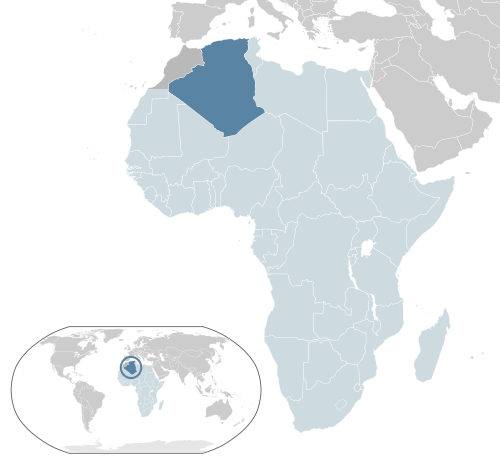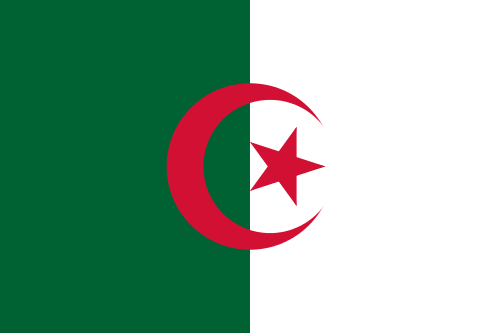© 2014 Yale M. Lansky a/k/a
Coinrav
All Rights Reserved. Permission to use on allnumis.com with proper acknowledgement and © Information posted is granted.
Algeria is a country located in Northern Africa, bordering the Mediterranean Sea, between Morocco and Tunisia. Algeria is bordered by Libya, Mali, Mauritania, Morocco, Niger, Tunisia and Western Sahara, and is the largest country in Africa. It has a land mass of 2,381,741 square km, making it the 10th largest country (regarding land mass) in the world. It is slightly more than 3.5 times the size of Texas, in the United States. Algeria's coastline is 998 km and it claims territorial waters of 12 nautical miles (nm) and an exclusive fishing zone of: 32-52 nm. Its climate is arid to semiarid; mild, wet winters with hot, dry summers along the coast; drier with cold winters and hot summers on high plateau; "sirocco" is a hot, dust/sand-laden wind especially common in the summer. This weather is conducive to spending time indoors working on one's Numismatic collection. [
1]
The flag of Algeria has a lot of meaning to it, just as the country's coins and banknotes. The flag's green represents Islam, white represents purity and peace, and red stands for liberty. The crescent and star are also Islamic symbols, but the crescent is more closed than those of other Muslim countries because the Algerians believe the long crescent horns bring happiness. [
2]
Algeria, also known as the People's Democratic Republic of Algeria, is known locally as Al Jumhuriyah al Jaza'iriyah ad Dimuqratiyah ash Sha'biyah or Al Jaza'ir for "short". The country has 48 provinces and won its independence from France on July 5, 1962. It adopted its own Constitution on September 8, 1963 (as amended) and is a combination of French civil law and Islamic law. Hydrocarbons have long been the backbone of the economy, accounting for roughly 60% of budget revenues, 30% of GDP, and over 95% of export earnings. Algeria has the 10th-largest reserves of natural gas in the world and is the sixth-largest gas exporter. It ranks 16th in oil reserves. Exchange Rates between Algerian dinars (DZD) per US dollar are high according the following figures: 78.77 DZD to $1 in (2013 est.),77.536 DZD to $1 in (2012 est.) 74.386 DZD to $1 in (2010 est.) , 72.65 DZD to $1 in (2009), and 63.25 DZD to $1 in (2008). [
3] This excellent exchange rate makes the numismatic marketplace comparable to that of the United States and the European Union.
The following is a history of Algeria's numismatics written by people who write for
daggarjon.com. This site is a similar site to allnumis.com, but is far more incomplete, except in the area of the histories of a country's numismatic history which it discusses on its website. Despite many possible drawbacks in using this website as my source, I have decided to do so as long as I can reasonably authenticate the facts. I obviously appreciate any help with this fact checking. [
4]
"The Phonecians established colonies in Algeria and the first coins were probably minted in Algeria around 200 BC and were issued in the names of local Mauritanian and Numidian kings. Numidia became part of the African province in 46 BC and Mauritania became a Roman province in AD 40. Roman coins were issued and imported for the next 400 years. After the fall of the Roman Empire, Vandal and Byzantine coins were used." [
5]
Sounds correct, but: ... "Algeria became part of the Muslim world around 700, but it wasn't until the twelfth century that substantial numbers of coins were minted in Algeria. From the eleventh to the fifteenth century, Algeria was part of the route by which West African gold reached Europe. The Europeans minted imitation silver Islamic coins to exchange them for the Muwahhid gold coinage minted in Algeria."
"Algeria (El Djazair) went under Ottoman rule in 1536 after it appealed to the Ottoman Empire for protection from Spanish intrusion. France invaded Algiers in 1830 to suppress piracy and had subdued most of the country by 1847. By 1848 the Algerian Atlas Mountain region was under French control, and France began to expand into the interior. Algeria's borders were established in the context of the scramble for Africa in the 1890s. A bitter guerilla war for independence began on November 1, 1954, and Algeria gained its independence from France on July 3, 1962." [
6]
Under the Ottoman Empire, the Asper was both the Unit of Account (DZA) and the primary form of specie money (DZS), though Portuguese and Spanish coins also circulated. The Asper was the lowest denomination coin. The Muzuna (29 Aspers), Saime/Double (50 Aspers) and Pataca (232 Aspers) were used as units of account. The Kharub (14 Aspers), Muzuna (29 Aspers), Pataca Gourda (696 Aspers), Sequin (1972 Aspers) and Zecchino (2320 Aspers) were used for coins. Before the French annexed Algeria, the Budju (DZB) had been issued as a local coin and was divisible into 24 Muzunas. No banknotes were issued before France occupied Algeria. [
7]
The French Franc became legal tender in Algeria in 1830. The Banque de l'Algerie was established on November 1, 1851 and had the monopoly right of issue of banknotes in Algeria. The French introduced the French Franc Germinal, allowing both French Francs (FRG) and banknotes issued by the Banque de l'Algerie (DZG) to circulate. The Franc was divisible into 100 Centimes. [
8] Most coins were French, but a few coins were struck for Algeria after the war.
Algeria went off the Gold Standard on June 30, 1937 and introduced exchange controls on September 10, 1939. On July 2, 1959, French and Algerian Francs were made legal tender in both countries. The Franc Nouveaux (FRF) replaced the Franc Germinal on January 1, 1960. The Banque de l'Algerie became the Banque de l'Algerie et de la Tunisie on January 12, 1949, issuing banknotes for both Algeria and Tunisia. When Tunisia gained its own central bank, the Banque de l'Algerie was reborn on November 3, 1958. Initially, the Banque Centrale d'Algerie, established on January 1, 1963, issued its own Algerian Franc (DZF), but this was replaced with the Algerian Dinar (DZD) on April 1, 1964. The Dinar is divisible into 100 Centimes.
Banknotes were issued by the Banque de l'Algerie beginning in 1852. The Banque de l'Algerie was the bank of issue under the French, the Vichy government and the Allies. The Banque de l'Algerie et de Tunisie took over the right to issue banknotes between 1940 and 1958. The Banque de l'Algerie issued banknotes between 1946 and 1964, and the Banque Centrale de l'Algerie (sic) has issued banknotes since Algeria gained its independence.
Footnotes:
- Sources Consulted: The World Factbook 2013-14. Washington, DC: Central Intelligence Agency, 2013, https://www.cia.gov/library/publications/the-world-factbook/geos/ag.html, accessed on 10/3/14.
- Ibid.
- Ibid.
- From: http://www.daggarjon.com/Coinage_Algeria.php "Visited" on: Sunday, 12 October 2014 05:34 pm and its Summer In Michigan. Please note that the time and date stamp is correct; but summer in the continental United States of America, of which Michigan is a part, ends on September 22nd for 2014, and Fall begins on the 23rd of September. With this type of error, we need to be cautious in accepting all their facts as correct.
- Ibid.
- CIA Fact Book puts this date at July 5th, 1962.
- Where does this information come from? Perhaps some of it would be better outlined in the K&M Series of World Coins but my resources are limited.
- Were there other denominations built on or around the 100 Centimes?

